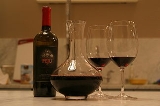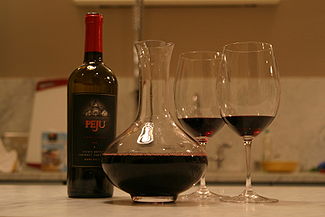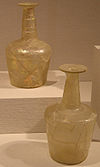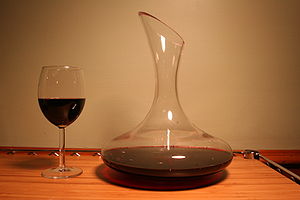
Decanter
Encyclopedia

Decantation
Decantation is a process for the separation of mixtures. This is achieved by carefully pouring a solution from a container in order to leave the precipitate in the bottom of the original container...
of a liquid (such as wine
Wine
Wine is an alcoholic beverage, made of fermented fruit juice, usually from grapes. The natural chemical balance of grapes lets them ferment without the addition of sugars, acids, enzymes, or other nutrients. Grape wine is produced by fermenting crushed grapes using various types of yeast. Yeast...
) which may contain sediment
Sediment
Sediment is naturally occurring material that is broken down by processes of weathering and erosion, and is subsequently transported by the action of fluids such as wind, water, or ice, and/or by the force of gravity acting on the particle itself....
. Decanters are normally used as serving vessels for wine. Decanters vary in shape and design. They are usually made of an inert
Inert
-Chemistry:In chemistry, the term inert is used to describe a substance that is not chemically reactive.The noble gases were previously known as inert gases because of their perceived lack of participation in any chemical reactions...
material (such as glass
Glass
Glass is an amorphous solid material. Glasses are typically brittle and optically transparent.The most familiar type of glass, used for centuries in windows and drinking vessels, is soda-lime glass, composed of about 75% silica plus Na2O, CaO, and several minor additives...
) and will hold at least one standard bottle
Wine bottle
A wine bottle is a bottle used for holding wine, generally made of glass. Some wines are fermented in the bottle, others are bottled only after fermentation. They come in a large variety of sizes, several named for Biblical kings and other figures. The standard bottle contains 750 ml,...
of wine (0.75 litre). A similar kind of vessel, the carafe
Carafe
The carafe , is used for serving wine and other drinks. Unlike the related [decanter], carafes do not include stoppers.Coffee Pots included in coffee makers are also referred to as carafes....
(kəˈræf), is used for serving wine as well as other drinks, but is not supplied with a stopper.
History

History of wine
The history of wine spans thousands of years and is closely intertwined with the history of agriculture, cuisine, civilization and humanity itself...
, decanters have played a significant role in the serving of wine. The vessels would be filled with wine from amphora
Amphora
An amphora is a type of vase-shaped, usually ceramic container with two handles and a long neck narrower than the body...
s and brought to the table where they could be more easily handled by a single servant. The Ancient Romans pioneered the use of glass as a material. After the fall of the Roman Empire, glass production was scarce causing the majority of decanters to be made of bronze
Bronze
Bronze is a metal alloy consisting primarily of copper, usually with tin as the main additive. It is hard and brittle, and it was particularly significant in antiquity, so much so that the Bronze Age was named after the metal...
, silver
Silver
Silver is a metallic chemical element with the chemical symbol Ag and atomic number 47. A soft, white, lustrous transition metal, it has the highest electrical conductivity of any element and the highest thermal conductivity of any metal...
, gold
Gold
Gold is a chemical element with the symbol Au and an atomic number of 79. Gold is a dense, soft, shiny, malleable and ductile metal. Pure gold has a bright yellow color and luster traditionally considered attractive, which it maintains without oxidizing in air or water. Chemically, gold is a...
, or earthenware
Earthenware
Earthenware is a common ceramic material, which is used extensively for pottery tableware and decorative objects.-Types of earthenware:Although body formulations vary between countries and even between individual makers, a generic composition is 25% ball clay, 28% kaolin, 32% quartz, and 15%...
. The Venetians
Venice
Venice is a city in northern Italy which is renowned for the beauty of its setting, its architecture and its artworks. It is the capital of the Veneto region...
reintroduced glass decanters during the Renaissance
Renaissance
The Renaissance was a cultural movement that spanned roughly the 14th to the 17th century, beginning in Italy in the Late Middle Ages and later spreading to the rest of Europe. The term is also used more loosely to refer to the historical era, but since the changes of the Renaissance were not...
period and pioneered the style of a long slender neck that opens to a wide body, increasing the exposed surface area of the wine, allowing it to react with air. In the 1730s, British
Kingdom of Great Britain
The former Kingdom of Great Britain, sometimes described as the 'United Kingdom of Great Britain', That the Two Kingdoms of Scotland and England, shall upon the 1st May next ensuing the date hereof, and forever after, be United into One Kingdom by the Name of GREAT BRITAIN. was a sovereign...
glass makers introduced the stopper
Stopper (plug)
A bung is truncated cylindrical or conical closure to seal a container, such as a bottle, tube or barrel. Unlike a lid which encloses a container from the outside without displacing the inner volume, a bung is partially inserted inside the container to act as a seal...
to limit exposure to air. Since then, there has been little change to the basic aspects of the decanter.
Other uses
Other beverages, such as cognacCognac (drink)
Cognac , named after the town of Cognac in France, is a variety of brandy. It is produced in the wine-growing region surrounding the town from which it takes its name, in the French Departements of Charente and Charente-Maritime....
or single malt Scotch
Single malt Scotch
Single Malt Scotch is whisky made in Scotland using a pot still distillation process at a single distillery, with malted barley as the only grain ingredient...
whisky, are often stored and served in decanters, which generally have a stopper. A few expensive cognacs and malt whiskies are sold in fancy decanters.
Wine decanting process
Liquid from another vessel is poured into the decanter in order to separate a small volume of liquid, containing the sedimentSediment
Sediment is naturally occurring material that is broken down by processes of weathering and erosion, and is subsequently transported by the action of fluids such as wind, water, or ice, and/or by the force of gravity acting on the particle itself....
, from a larger volume of "clear" liquid, which is free of such. In the process, the sediment is left in the original vessel, and the clear liquid is transferred to the decanter.
Decanters have been used for serving wines that are laden with sediments in the original bottle. These sediments could be the result of a very old wine or one that was not filtered or clarified during the winemaking
Winemaking
Winemaking, or vinification, is the production of wine, starting with selection of the grapes or other produce and ending with bottling the finished wine. Although most wine is made from grapes, it may also be made from other fruit or non-toxic plant material...
process. In most modern winemaking, the need to decant for this purpose has been significantly reduced, because many wines no longer produce a significant amount of sediment as they age.
Aeration

Aeration
Aeration is the process by which air is circulated through, mixed with or dissolved in a liquid or substance.-Aeration of liquids:-Methods:Aeration of liquids is achieved by:...
it, or allow it to "breathe". The decanter is meant to mimic the effects of swirling the wine glass to stimulate the movement of molecules in the wine to trigger the release of more aroma compounds. In addition it is thought to benefit the wine by smoothing some of the harsher aspects of the wine (like tannins or potential wine faults like mercaptans). Many wine writers, such as author Karen MacNeil
Karen MacNeil
Karen MacNeil is an American author, journalist, wine educator and consultant based in Napa Valley. MacNeil is also the creator and chairman of the Rudd Center for Professional Wine Studies at the Culinary Institute of America in St...
in the book The Wine Bible, advocate decanting for the purposes of aeration, especially with very tannic wines like Barolo
Barolo
Barolo is a red Denominazione di Origine Controllata e Garantita wine produced in the northern Italian region of Piedmont. It is made from the Nebbiolo grape and is often described as one of Italy's greatest wines...
, Bordeaux
Bordeaux wine
A Bordeaux wine is any wine produced in the Bordeaux region of France. Average vintages produce over 700 million bottles of Bordeaux wine, ranging from large quantities of everyday table wine, to some of the most expensive and prestigious wines in the world...
, Cabernet Sauvignon
Cabernet Sauvignon
Cabernet Sauvignon is one of the world's most widely recognized red wine grape varieties. It is grown in nearly every major wine producing country among a diverse spectrum of climates from Canada's Okanagan Valley to Lebanon's Beqaa Valley...
, Port
Port wine
Port wine is a Portuguese fortified wine produced exclusively in the Douro Valley in the northern provinces of Portugal. It is typically a sweet, red wine, often served as a dessert wine, and comes in dry, semi-dry, and white varieties...
, and Rhône wines while noting that decanting could be harmful for more delicate wines like Chianti
Chianti
Chianti is a red Italian wine produced in Tuscany. It was historically associated with a squat bottle enclosed in a straw basket, called a fiasco ; however, the fiasco is only used by a few makers of the wine now; most Chianti is now bottled in more standard shaped wine bottles...
and Pinot Noir
Pinot Noir
Pinot noir is a black wine grape variety of the species Vitis vinifera. The name may also refer to wines created predominantly from Pinot noir grapes...
.
However the effectiveness of decanting is a topic of debate, with some wine experts like oenologist Émile Peynaud claiming that the prolonged exposure to oxygen actually diffuses and dissipates more aroma compounds than it stimulates, in contrast to the effects of the smaller scale exposure and immediate release that swirling the wine in a drinker's glass has. In addition it has been reported that the process of decanting over a period of a few hours does not have the effect of softening tannins. The softening of tannins occurs during the winemaking and oak aging when tannins go through a process of polymerization
Polymerization
In polymer chemistry, polymerization is a process of reacting monomer molecules together in a chemical reaction to form three-dimensional networks or polymer chains...
that can last days or weeks - decanting merely alters the perception of sulfites and other chemical compounds in the wine through oxidation, which can give some drinkers the sense of softer tannins in the wine.
Some wine experts, like writer Jancis Robinson
Jancis Robinson
Jancis Mary Robinson OBE, MW is a British wine critic, journalist and editor of wine literature. She currently writes a weekly column for the Financial Times, and writes for her website jancisrobinson.com...
, tout the aesthetic value of using a decanter, especially one with an elegant design and made with clear glass, and believe that for all but the most fragile of wines that there is not much significant damage to the wine by decanting it. A decanter is also a way of presenting wine anonymously, and of disguising ugly wine labels.

